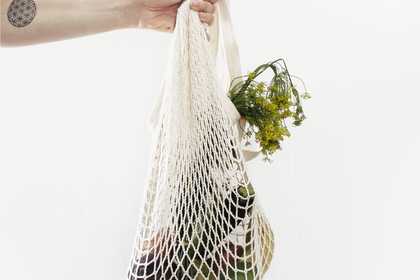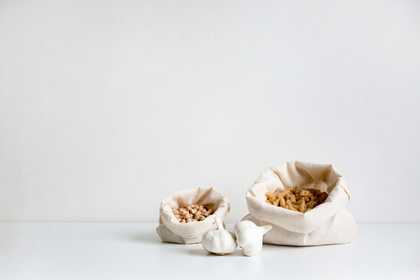How to achieve zero waste around your home

Sustainability is the word on everyone’s lips at the moments and for a good reason; with an increasing number of the products that we use every day ending up in landfill sights, there is a push to find more environmentally-friendly options.
Many people are adopting a zero-waste lifestyle as a means of lowering the number of things put in landfills. From disposable cups and pre-packaged vegetables to baby wipes and items that can only be used once, making more conscious decisions when purchasing things can massively reduce your carbon footprint.
We asked Joy from sustainability blog Sustainable Jungle what the concept of zero waste meant to her. She shared this with us: “‘Zero Waste’ is analogous to the concept of the circular economy but designed for us as individuals. In practice, this simply means not buying or using things you don't need, substituting traditional products with no or low-waste packaging alternatives, composting organic matter like food waste and recycling packaging that could not be substituted. The goal for a "zero waster" is to have a tiny, tiny trash bin that gets sent to landfill very rarely and ultimately, to have no trash at all. Adopting a zero-waste lifestyle (or even some form of it) sends a very clear message that we, humans that care, want change for the better.”
If you’re thinking about reducing your waste, take a look at this guide and find out how you can start making the move towards a zero-waste life.
What is zero waste?

Zero waste is a movement in which people are looking to reduce the amount of rubbish that they accumulate from products around the home, food, and clothing. With the aim to throw away as little as possible, looking for green companies who have adopted this initiative is one of the easiest ways to make steps towards becoming zero waste.
The kitchen, in particular, is a great place where you can cut back on non-recyclable materials and make a move towards this lifestyle. Food wastage is highly preventable, yet everyday fresh produce is going to waste. One of the easiest ways to eliminate this wastage is to create a weekly meal plan and stick to it. Prepping your meals for the upcoming days is one of the best ways to stick to this, especially as you have already put in the hard work. Simply flick through a few cookbooks for inspiration and go shopping.
Despite food waste resulting from over-purchasing, buying certain things in bulk, such as pasta and other grains, can cut down on plastic rubbish. Another way that you can cut back on plastic waste is by attending a greengrocer or a farmer’s market. These typically have the produce on display, so you can pick up as much (or as little) of one item as you’d like.
In the bathroom, buying products such as shampoo and conditioner can mean that you’re regularly left with empty bottles. Plus, if you’re interested in trying out the latest beauty and skincare products, you may find that these are discarded, resulting in more empty containers that will need recycling in the near future.
How can I become zero waste?

We spoke to Charlotte from the blog A Zero Waste Life for her opinion of what living zero waste means: “For me, Zero Waste means sending nothing to landfill. Zero Waste Living has helped me feel more connected to my local community. I feel like the small choices I make build up to have a big impact on the world around me- and these choices now save me money!
“Going Zero Waste feels overwhelming at first, so start by looking at what you're already doing well and figure out what the next step could be. Start small, but be consistent, and before you know it you'll find the zero waste swaps as rewarding to make as I did!”
It is important to remember that a zero-waste lifestyle isn’t always attainable. Although it is a goal, there will be things that you use on a daily basis that you simply can’t part with. When remembering this, it is equally as crucial to not feel deterred by your progress.
Becoming zero waste is a marathon, not a sprint, so make sure that you work out a plan for the best way to adopt this practice. Splitting your house into different sections, such as the bathroom and the kitchen, means that you can work out where you’re making the most waste and start from there.
What are some easy zero waste lifehacks in the home?

There are lots of ways that you can make positive changes at home. Single-use products such as straws and tissues have more sustainable alternatives, so invest in a handkerchief or metal straw to use around your home. Not only are these better for the environment but will save you money. Making investments in items will also make you more aware of your spending habits, encouraging you to make informed purchasing decisions.
Shopping second-hand is a great option for those who can’t quite quit shopping. Charity shops, car boot sales, online resellers such as eBay and Depop – all of these are great options at reducing your footprint whilst helping you pick up things for a fraction of the price. Plus, if you’re planning on downsizing, it is a fantastic way of getting rid of unwanted items.
The great thing about working towards becoming zero waste is that many of the steps you can take are intuitive. Think about the frequency you’re washing your clothes, buying single-use plastic bags when food shopping and how many times you’ve recently thrown food away as it has spoiled or gone-off? Highlighting an area that you could improve upon and working towards that goal can often see other areas improve too. Practice makes perfect though and despite you cutting back in certain areas, others will need a little bit of a push.
If you’re working towards a goal of becoming zero waste, why not treat yourself to a couples spa break in Yorkshire?
